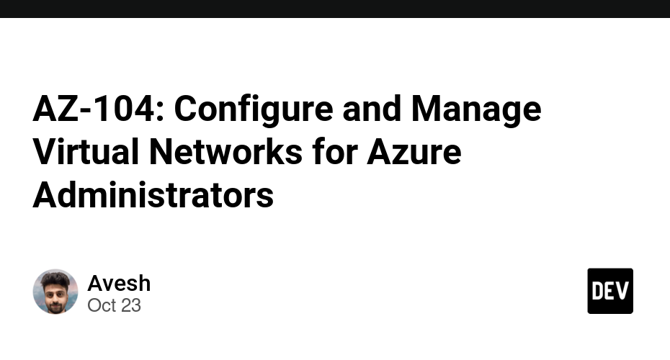Dev
3w
8

Image Credit: Dev
AZ-104: Configure and Manage Virtual Networks for Azure Administrators
- AZ-104 is a certification exam for Microsoft Azure administrators, and configuring and managing virtual networks (VNet) in Azure is one of the key skills required for this exam.
- A Virtual Network (VNet) in Azure is a logical isolation of the Azure cloud dedicated to your subscription. It enables Azure resources to securely communicate with each other.
- To create and configure a Virtual Network in Azure, you need to create a Virtual Network, configure subnets to divide the VNet, and Network Security Groups (NSGs) for traffic filtering.
- A subnet is a segment of the VNet where resources are deployed. Each subnet has its own range of IP addresses, which is part of the overall VNet address space.
- Network Security Groups (NSGs) are used to control network traffic to and from Azure resources within a VNet. NSGs contain a list of security rules that allow or deny inbound or outbound traffic based on IP addresses.
- VNet Peering allows you to connect two VNets, enabling traffic to flow between them as if they are on the same network. This connection is private and uses Microsoft’s backbone network.
- VNet-to-VNet VPN allows VNets to connect across different Azure regions or subscriptions via a secure IPsec VPN tunnel, while Site-to-Site VPN enables on-premises networks to connect securely to Azure VNets.
- ExpressRoute provides a private, dedicated connection between your on-premises infrastructure and Azure, bypassing the public internet. It is ideal for mission-critical workloads that require high performance and reliability.
- Azure offers several options for distributing traffic across multiple resources, ensuring high availability and scalability and Azure DNS allows you to host your domain names in Azure and manage DNS records for your services.
- Some of the best practices to keep in mind are planning IP addressing carefully, using NSGs, monitoring traffic, using VNet peering, leveraging ExpressRoute, and practicing subnetting.
Read Full Article
Like
For uninterrupted reading, download the app